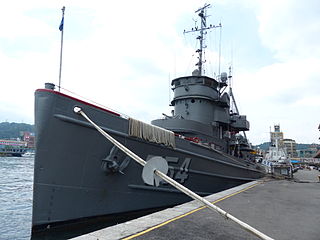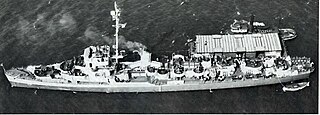
USS Douglas H. Fox (DD-779) was an Allen M. Sumner-class destroyer of the United States Navy.

USS Abnaki (ATF-96) was the lead ship of the Abnaki class of fleet ocean tugs in the service of the United States Navy, named after the Abenaki tribe of Native Americans. She was laid down on 28 November 1942 at Charleston, South Carolina by Charleston Shipbuilding & Drydock, launched on 22 April 1943, sponsored by Mrs. James Mayon Jones, and commissioned at the Charleston Navy Yard on 25 November 1943 with Lt. Dewey Walley in command. Abnaki earned three battle stars for service during the Korean War and 10 battle stars during the Vietnam War.

USS Achomawi (AT-148/ATF-148) was an Abnaki-class fleet ocean tugs in the service of the United States Navy, and was named for the Achomawi tribe of Native Americans.

USS Mullany (DD-528), a Fletcher-class destroyer, was the second ship of the United States Navy to be named for Rear Admiral James Robert Madison Mullany (1818–1887).

USS Willard Keith (DD-775), an Allen M. Sumner-class destroyer, is currently the only completed ship of the United States Navy ever named for Willard Keith, a United States Marine Corps captain who died in combat during the campaign for Guadalcanal. He was awarded the Navy Cross for his actions.
USS Arikara (AT-98) was an Abnaki-class of fleet ocean tug. It was named after the Arikara, a loose confederacy of sub-tribes of American Indians related to the Pawnee. The Arikara inhabited villages in the Missouri River valley.

USS Burke (DE-215/APD-65), a Buckley-class destroyer escort of the United States Navy, was named in honor of Lieutenant Commander John E. Burke (1905–1942), who was killed in action, aboard the battleship South Dakota during the Naval Battle of Guadalcanal on 15 November 1942.

USS Bowers (DE-637/APD-40), a Buckley class destroyer escort of the United States Navy, was named in honor of Ensign Robert K. Bowers (1915-1941), who was killed in action aboard the battleship USS California during the Japanese attack on Pearl Harbor on 7 December 1941.

USS Thomas J. Gary (DE-326) was an Edsall-class destroyer escort. The ship was renamed Thomas J. Gary on 1 January 1945 to free the name for planned light cruiser USS Gary (CL-147).

USS Cahuilla (ATF-152) was an Abnaki class fleet tug in the service of the United States Navy during World War II. In 1961 she was sold to the Argentine Navy as ARA Irigoyen (A-1) where she served until 2009 when she became a Museum ship.

USS Otterstetter (DE-244) was an Edsall-class destroyer escort built for the U.S. Navy during World War II. She served in the Atlantic Ocean the Pacific Ocean and provided destroyer escort protection against submarine and air attack for Navy vessels and convoys.

USS Lipan (AT-85) was a Navajo-class fleet tug constructed for the United States Navy during World War II. Her purpose was to aid ships, usually by towing, on the high seas or in combat or post-combat areas, plus "other duties as assigned." She served in the Pacific Ocean during World War II and the Korean War. She was awarded two battle stars for World War II and four battle stars for the Korean War.

USS Seneca (AT-91) was a Navajo-class fleet tug constructed for the United States Navy during World War II. Her purpose was to aid ships, usually by towing, on the high seas or in combat or post-combat areas, plus "other duties as assigned." She served in the Atlantic Ocean performing various tasks.
USS Arapaho (AT-68/ATF-68) was a Navajo-class fleet ocean tug which served the U.S. Navy during World War II with her towing services. She was assigned initially to support the U.S. Atlantic Fleet, and was eventually assigned to support Allied forces in the war zones of the Pacific Ocean, resulting in her crew returning home after the war with four battle stars to their credit.

USS Ringness (APD-100) was a Crosley-class high speed transport that served in the United States Navy from 1944 to 1946. After spending 29 years in reserve, she was sold for scrapping in 1975.

USS Tollberg (APD-103) was a United States Navy high-speed transport in commission from 1945 to 1946. In 1965, Tollberg was transferred to Colombia and served as ARC Almirante Padilla (DT-03) until being stricken and scrapped in 1973.

USS Apache (AT-67/ATF-67) was a Navajo-class fleet tug, later fleet ocean tug, in commission in the United States Navy from 1942 to 1946 and from 1951 to 1974. She saw service in World War II, the Korean War, and the Vietnam War.
USS Chippewa (AT-69) was a Navajo-class fleet tug constructed for the United States Navy during World War II. Her purpose was to aid ships, usually by towing, on the high seas or in combat or post-combat areas, plus "other duties as assigned." She served in the Atlantic Ocean.

USS Choctaw (AT-70) was a Navajo-class fleet tug constructed for the United States Navy during World War II. Her purpose was to aid ships, usually by towing, on the high seas or in combat or post-combat areas, plus "other duties as assigned." She served in Bermuda during the end of World War II where she was primarily responsible to aiding in the assembly of convoys and ships taking part in training. On 15 May 1944, she was redesignated ATF-70. She continued to serve for 3 more years before being decommissioned on 11 March 1947.

USS Jicarilla (ATF-104) was Abnaki-class tugboat during the World War II. The ship was later sold to Colombia as ARC Sebastián De Belalcázar (RM-73). Her namesake is a group of the Apache tribe found in the southwestern United States.

















